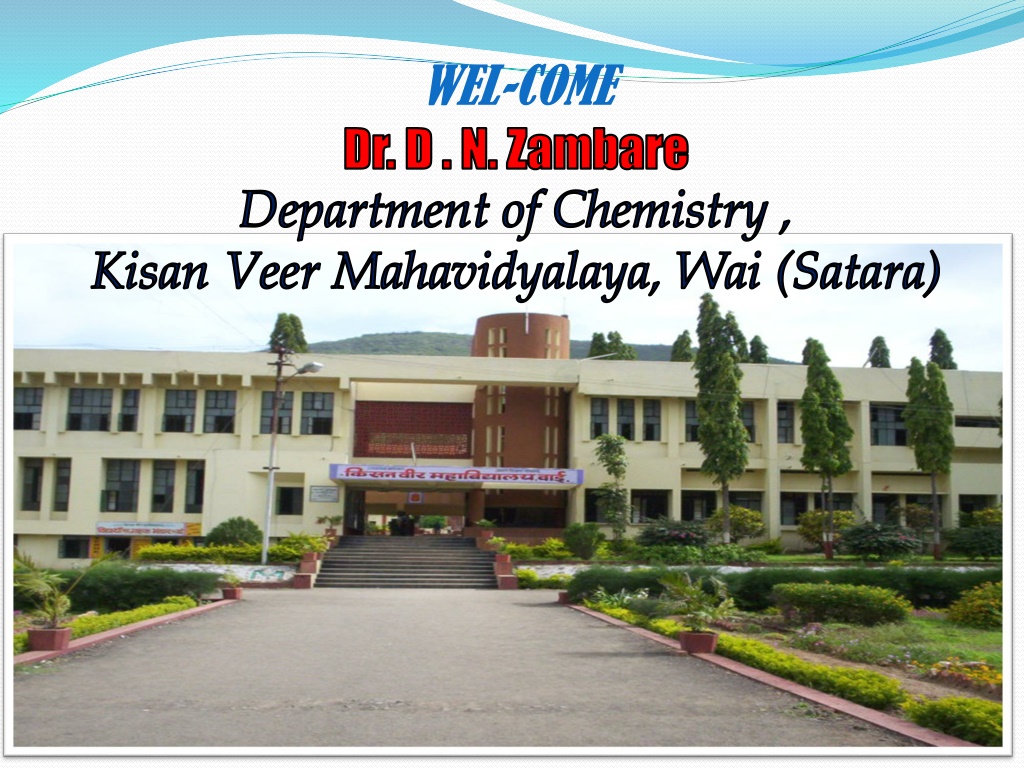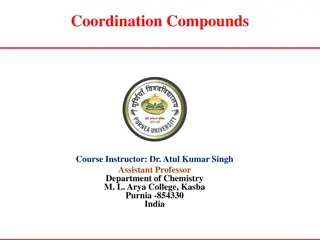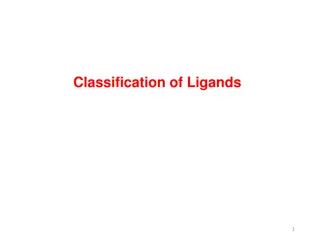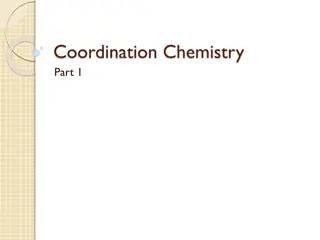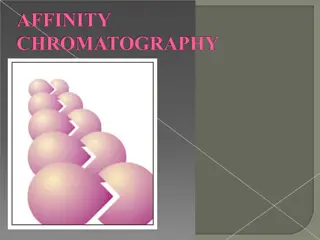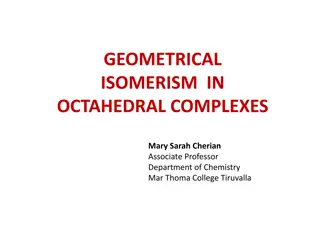Understanding Chelation Chemistry: Structural Requirements, Ligands, and Applications
Chelation chemistry involves the formation of specific complexes known as chelates, characterized by ligands that coordinate with a central metal ion. This article explores the structural requirements for chelate formation, the role of chelating agents like EDTA and DMG, and the difference between metal chelates and metal complexes. It delves into the classification of chelating agents based on donor groups, the process of chelation, and the significance of symmetrical shape in stable metal chelates. Additionally, it highlights the historical development of chelate chemistry and the contributions of pioneers like Alfred Werner.
Download Presentation

Please find below an Image/Link to download the presentation.
The content on the website is provided AS IS for your information and personal use only. It may not be sold, licensed, or shared on other websites without obtaining consent from the author. Download presentation by click this link. If you encounter any issues during the download, it is possible that the publisher has removed the file from their server.
E N D
Presentation Transcript
WEL-COME Dr. D . N. Zambare Department of Chemistry , Kisan Veer Mahavidyalaya, Wai (Satara)
Chapter 2Chelation Contents 2.1 A Brief Introduction with respect to Ligands, Chelating Agent, Chelation and Metal Chelate 2.2 Structural Requirements of Chelate Formation 2.3 Difference between Metal Chelate and Metal Complex 2.4 Classification of Chelating Agents (with Specific Illustration of Bidentate Chelating Agents) 2.5 Application of Chelation with respect to Chelating Agents EDTA and DMG
Introduction (A brief introduction with respect to ligands, chelating agent, chelation and metal chelate.) Chelation is a highly specific and special type of complex formation. What has been considered for simple complexation applies equally well to chelate formation. Alfred Werner was the first to describe this type of complexation but the development of chelate chemistry is quite recent. The parent word Chelate was coined in 1920 by G.T. Morgan and H.D.A. Drew. This term is derived from the greek word, chele, or chelos, meaning Crab s claw; that points out the tenacity with which the co-coordinating group holds the metal ion due to the complex formation.The complex means cluster containing a central metal atom or an ion surrounded by a set of ligands. (i) Ligands: A group of atoms, ions or molecules which is co-ordinated or directly linked or complexed to the central metal ion is called as ligands . (e.g., NH3, H2O, CN , SCN , Cl etc.)
(ii) agent . (e.g. en, dmg, edta, etc). In other words, the substance having any ligands that bridge two or more coordination positions is called as a chelating agent. On the basis of the total number of donor groups, present in the chelate, the chelating agents are classified as: (1) Bidentate two toothed (having two donor groups), (2) Tridentate three toothed (having three donor groups), (3) Quadridentate four toothed (having four donor groups); etc. and further as pentadentate, haxadentate etc. chelating agents, respectively. (iii) Chelation: The process of formation of a heterocyclic ring containing metal atom or ion is called as chelation . i.e. the process of formation of a special complex by cyclization is called as chelation. i.e. Metal ion + Chelating agent Chelation(((((((,\s\do8((HeterocyclizatMetal chelate (iv) Metal chelate: The process of formation of a heterocyclic ring containing a metal ion which is being attached to two or more non-metallic atoms from the same molecule, by coordinate or covalent or by both the links, the resulting substance is called a metal chelate . Chelating agent: The substance containing two or more donor groups is called a chelating
2.2 Structural Requirements of Chelate Formation In this connection, metal chelates may be characterized by the following requirements: 1. Heterocyclic ring: In the formation of metal chelate, formation of heterocyclic ring is most essential. 2. Size and charge: Small size and high charge on the central metal, normally favour chelate formation. 3. Type of bonding: Bonding in metal chelates is either covalent, co-ordinate or a combination or both. 4. Donor groups: The chelating agents must have at least two donor groups, having donor atoms with lone pairs of electrons; such as nitrogen, oxygen and sulphur; belonging to groups VA(15)th and VIA (16)th. 5. Symmetrical shape: The stable metal chelate should possess a symmetrical shape. But they may or may not have regular shape. 6. The five membered ring (strain-free): The chelate ring must be of the five atoms, including the metal ion (thus the steric crowding is avoided and the stability is increased. The five membered ring is practically strain-free as its bond angle is 108 that corresponds to the tetrahedral angle 109.5 ).
7. molecules. More the number of donor groups, more the rings that are formed, and the more stable the chelate is. 8. Ring closure: In the formation of metal chelates, the ring must be closed by covalent or co-ordinate bonding or by a combination of both. This requirement is fulfilled by two kinds of functional groups: I. Covalent bonding: The covalent linkages are produced by the replacement of a proton in an organic group. Hence such functional groups are sometimes called acidic groups, from which hydrogen may be replaced. The examples of such functional groups are: COOH (Carboxyl), OH (Enolic hydroxyl) and SH (Thioenolic), SO3H (Sulphonic), and N.OH (Oxime). Such functional groups are called acidic groups, from which hydrogen is replaced. II. Coordinate bonding: The co-ordinate bonds without the replacement of hydrogen are formed by the donation of electron pairs from donor groups in chelate ligands. The examples of such functional groups are: NH2, = NH, N (Primary, secondary and tertiary amines) OH (Alcoholic, hydroxyl), = CO (Carbonyl), S-(Thioether), and =N.OH (Oxime). Chelation will be favoured provided that the functional groups occur at the 1, 4 or sometimes at the 1, 5 positions of the organic molecule (chelating agent). The metal chelates should have high stability: The metal must have higher coordination number. It must bind with more number of ligand
Difference between Metal Chelate and Metal Complex Metal Chelate Metal Complex 1. A special form of complex obtained by cyclization is called a metal chelate. 1. An addition compound obtained by complex formation without cyclization is called a metal complex. 2. Metal complexes non-cyclic molecular comp- ounds. 3. In complexation, metal ion combines with a reagent having an electron pair donor. 2. Metal chelates are essentially special kinds of heterocyclic ring compounds. 3. In chelate formation, metal ion combines with organic reagents, having two or more donor groups. are 4. The substance containing two or more donor groups is called a chelating agent. It is bidentate, tridentate, polydentate. e.g. en, dmg, edta, etc. Such reagents form metal chelates. 4. The substance containing a simple donor group is called a complexing agent. monodentate e.g. H2O, NH3, Cl , etc. It is responsible to form metal complexes. It is or 5. Bonding in metal chelates is either covalent, co-ordinate or a combination or both. 5. Bonding in metal complex is essentially a co-ordinate covalent.
6. In metal chelates, metal is firmly bound in strain-free rings. Metal chelates thus possess extra ordinary stability. 6. Metal complex is formed by linking with monodentate ligands through co-ordinate linkages. Hence they are moderately stable. 7. Metal dissociated in solution. chelates are negligibly 7. Metal complexes may dissociate to some extent in solution. 8. Metal chelates may or may not have regular shape. 8. Metal complexes have distinct and regular shape, viz. square planar, octahedral, tetrahedral, etc. 9. Metal chelates may or may not be represented in square brackets. 9. Metal complexes are represented with bracket enclosed symbols, [ ]. e.g. K4[Fe(CN)6] 10. Small size and high charge on the central metal, normally favour chelate formation. e.g. [Al(OX)3]3 . Here Al is non- transitional metal with (3+) charge. 10. Moderate size and even low charge on metal can favour complex formation. e.g. [Ni(CO)4]. Here Ni is with zero charge. 11. Example where, M(X X)2 Say: Bis-(ethylenediamine) copper(II) ion 11. Example where complexing agent MX4 metal chelate Say: chelating agent metal chelate Tetrammine copper(II) ion
2.4 Classification of Chelating Agents (With specific illustration of bidentate chelating agents) According to H. Diehl,classification of chelating agents is carried out on the basis of: (a) The total number of donor groups, present in the chelation i.e. agents lead to classification as: (1) Bidentate two toothed (having two donor groups), (2) Tridentate three toothed (having three donor groups), (3) Quadridentate four toothed (having four donor groups); etc. and further as pentadentate, haxadentate etc. chelating agents, respectively. (b) On the basis of the relative number of acidic and co-ordinating groups involved in ring closure the classification of chelating agents may be carried out as follows, say for bidentate chelating agents as: Bidentate Chelating Agents having: (i) Two acidic groups: Carbonic acid, Sulphuric, Oxalic acid, Malonic acid, Phthalic acid, Glycolic acid, Salicylic acid, -Benzoin etc. (ii) One acidic and one co-ordinating group: Glycine, Oxine, etc. (iii) Two co-ordinating groups: Ethylenediamine, Orthophenanthroline, - ' Dipyridyl, etc. To comprehend the system of classification of chelating agents, let us consider few illustrations regarding structures of metal chelates. Bidentate chelate with
(i)Two acidic groups Bis-(oxalato) platinate (II) ion Bis-(salicylato) cuprate (II) ion (ii) One acidic and one co-ordinating group: Bis-(8-Hydroxyquinolinato) zinc (II) ion (iii) Two co-ordinating groups: Tris (ethylenediamine) cobalt (III) ion Tris (Orthophenanthroline) iron (II) ion
Table 2.1: Types of Bidentate Chelating Agents Name (a) Bidentate: (Two acidic groups) 1. Oxalic acid Structure, Donor group COOH* | COOH* COOH* COOH* 2. Malonic acid H2C 3. Phthalic acid 4. Salicylic acid 5. Glycolic acid OCH2COO* H2* H* H (b) Bidentate: (One acidic and one co-ordinating group) 1. Glycine NCH2COO* H 2. 8-Hydroxyquinoline (oxine) (c) Bidentate: (Two basic or co-ordinating groups): 1. Ethylenediamine H2C * H2C * NH2 NH2
EDTA (Ethylenediamine Tetra-acetic acid) It is known as Versene, Sequesterene, and Trilon-B etc. It is one of the most versatile reagents used in analytical chemistry. EDTA occupies an eminent position among complexones. Its importance and wide applicability stem from its peculiar features, viz. (a) It is a white crystalline solid; its cost is comparatively low. (b) Its disodium salt and its chelates are highly soluble in water. Its molecular weight is 372.27. (c) It has very strong chelating ability, on account of two co- ordinating (*) and four covalent ( ) tendencies. (d) It can form stable chelates with almost all the metals, in the periodic table by binding them through five- five membered rings. (e) It serves as a primary standard and may be prepared with sufficient purity and remarkable stability. Structure of EDTA: 2.5 Application of Chelation with respect to Chelating (i) Reaction of EDTA: Ca++ + Na2H2EDTA Na2 [Ca EDTA] + 2H+
Applications of EDTA: The important applications of EDTA are as enlisted below: 1. Estimation of Cation: In complexometric titrations it is used as a titrant in estimation of as many as 40 cations viz. Ca, Mg, Zn, Al, Fe, Cr, Co, Ni, Cu, Cd, Hg, Bi, Sc, U lanthanons (rare earths), etc. 2. Estimation of Anions: As a titrant EDTA is used in the estimation of anions such as F , CrO, SO, AsO,,P2O, [Fe(CN)6]4 , etc. 3. Analysis of Technological Materials: The technological materials such as ores, minerals, slags, alloys, rocks, cements, leather, paints, oils, petrol, etc. can be analyzed by using EDTA as an analytical reagent. 4. Masking Agent: Polarographic determination of antimony in alloys is carried out by masking the interfering ion Cu2+by EDTA.
5. Industrial Applications: On commercial scale, EDTA finds enumerable applications, such as: (a) Food preservation, (b) Water softening, (c) Evaluation of total hardness of water, (d) Removal of iron from water supply, (e) Estimation of traces of copper from steel, (f) Colorimetric estimation of cations, (g) Estimation of Co, Ga, Zn, Pb, Mn, etc. in paint driers. (h) Removal of objectionable metal ions viz. Cu, Cr, Ni, Fe, Pb, etc. from body fluids. (i) Prevention of metal ions from precipitation in manures, from Mn, Fe, Zn, etc. (j) Treatment of acute and chronic lead poisoning, etc. The details of some of the applications are mentioned below for detailed study. (a)Food Preservation: It is our common experience that a cut apple becomes brown, orange juice loses its flavors, fats and oils become rancid, vitamin C and green vegetables get spoiled on keeping, cooked food gets spoiled on long standing, etc. All these are partly because of the presence of traces of metal ions in the atmosphere. Even one part of metal ion per million parts of food material, catalyses atmospheric oxidation and damages food material. The food may be preserved by binding the traces of metals by chelation. Use of a very dilute solution (0.01%) of EDTA is found to be quite useful in improving/keeping qualities of food.
(b)Water Softening: This is one of the most important applications of chelation. Water softening is most essential in power houses and chemical industry. Due to dissolved salts of calcium and magnesium, water becomes hard. When sequestering agents such as EDTA etc. are added to water, they combine with objectionable metal ions and form water soluble stable chelates and water becomes soft. (c) Evaluation of Total Hardness of Water: Water becomes hard when Ca2+ and Mg2+ ions are present in it. The total concentration of calcium and magnesium is measured in terms of CaCO3 expressed in ppm, by complexometric titration. A known volume of hard water is titrated against standard solution of EDTA, using Eriochrome black-T as an indicator. It gives wine red to sky blue end point. From the volume of EDTA required, the total hardness of water is then evaluated. 1 mole EDTA (d) Removal of Iron from Water Supply: Dissolved salts of iron in water supply form sediment on standing. Iron spoils the taste of tea. It decolourises water tubs, bath tubes and linen. On domestic scale, it is not possible to remove iron from water supply. If disodium salt of EDTA is added to water, iron gets bind with EDTA and five five member chelate rings are formed and it is hidden away (sequestered) by chelating. Iron is still there but it cannot be detected and thus its ill effects are stopped. Water becomes sparkling clear and free from sediments. Fe+++ + EDTA (disodium salt) 1 mole CaCO3 1 mole EDTA 1 mole Mg2+ 1 mole MgCO3
(e) this method, EDTA and DEDTC (sodium diethyldithio carbamate) are used together where EDTA binds all the iron (along with Cr, Co and Ni) while DEDTC binds all the copper alone. The copper chelate is intensely colored. It is extracted in organic solvent, the colour intensity of chelate is measured by colorimeter and the extent of copper in steel is evaluated. (f) Separation and Purification of Metals: Metals which resemble chemically are rather difficult to separate and purify. However, this can be achieved to utmost satisfaction by precipitation, ion-exchange or solvent extraction via chelating. For example, separation and purification of lanthanides, actinides and fission products of uranium, etc. are possible by using EDTA via ion exchange method. (g) Volumetric Analysis: Chelating agents are frequently used as titrants and indicators in titrimetric analysis of different metal ions. For example, EDTA for Zn, Ca, Mg, Fe etc. as a titrant. Erio-T, Murexide, Xylenol Orange, etc. as the indicators, in complexometric titrations. (h) Colorimetric Estimation: Transition metals form intensely coloured chelate complexes. By making use of this property, trace quantities of metal ions can be determined by measuring their optical density by colorimetric method. For example, nickel by DMG; Iron(II) by dipyridyl or o- phenanthroline, etc. Detection of traces of Copper in Steel: Sample of steel is treated with two chelating agents simultaneously. In
(i) plants, by avoiding their precipitation. i.e. anionic chelates containing aminopoly carboxylic acids are used for the treatment of Fe, Mn and Zn deficiency in plants. (j) In Drug Industry: Many chelates are used as drugs on account of their vitally important therapeutic roles.e.g. EDTA is useful to speed up the elimination of harmful radio-active metals from the body. The drinking of aqueous solution of calcium chelate Na2[CaEDTA] is quite useful for the treatment of acute and chronic lead and or copper poisoning.Dermatitis from chromium and nickel salts is treated with EDTA cream. 6. Uses in Physiological Chemistry: (i) Chlorophyll and haemoglobin which are chelates of magnesium and iron respectively play the most important and indispensable roles in life processes. (ii) Citric acid, malic acid, tartaric acid, etc. which are natural chelating agents help to keep metal ions in body fluids, without precipitation. (iii) EDTA is useful to speed up the elimination of harmful radio-active metals from the body. The calcium chelate Na2[CaEDTA] is quite useful for the treatment for acute and chronic lead poisoning, etc. (iv) Oxine metal chelate acts as an anti-fungal and antibacterial agent. (v) Anionic chelates containing aminopolycarboxylic acids are used for the treatment of Fe, Mn and Zn deficiency in plants, and so on. In Agriculture: EDTA complexes when applied with manures make the metals available to the
(ii) determination of nickel in steel, in 1907 by O. Brunek. It is a white crystalline solid, sparingly soluble in water. Its molecular mass is 116.4. It dissolves freely in alcohol and gives a clear and colourless solution. It melts at 236 C (509 K) with decomposition. It is highly specific, sensitive and selective reagent for nickel. Its 1% alcoholic solution is used in qualitative and quantitative analysis of nickel. It precipitates nickel as a voluminous, beautiful, scarlet red coloured, crystalline salt when an excess of reagent is added to nickel solution, followed by addition of ammonia and acetic acid but easily dissolves in dilute mineral acids. Traces of nickel (0.01 mg) can easily be detected by DMG. The reagent has very high sensitivity towards nickel; say one part in 20,00,000 parts of solution. Nickel can be detected, confirmed and estimated by gravimetric, titrimetric and colorimetric method; by using DMG as a selective reagent. DMG may be used as a reagent even for Bi, Fe and Pd. Its structure and reaction may be represented as follows: Structure of DMG: CH3 C = OH CH3 C - OH Dimethyl glyoxime CH3 C - Dimethyl glyoxime DMG (Dimethyl Glyoxime): DMG was discovered in 1905, by L.Tschugaeff. It was used as a reagent for the CH3 C = N OH * * N OH
Reaction of DMG: 2C4H8O2N2 (DMG) + NiCl2 + 2NH4OH C8H14O4N4 Ni + 2NH4Cl + 2H2O Structure of Ni - DMG Chelate: Bis-(Dimethyl glyoximato) nickel (II) Applications of DMG: 1. Detection of Ni: Solution of nickel salt is treated with 1% alcoholic DMG followed by addition of ammonia. The resulting solution is boiled and cooled
whereby scarlet red coloured beautiful crystalline solid precipitates out. This indicates the presence of nickel. 2. Spot Test of Ni: Drop of solution is applied on spot paper, drop of DMG is added to it and paper is exposed to ammonia vapours. Appearance of a red spot or red ring confirms the presence of nickel. 3. Gravimetric Estimation of Ni: Acidified solution of nickel is boiled. It is then treated with an excess of 1% alcoholic DMG. Aqueous ammonia is added till the precipitation is complete. The precipitate is then digested, filtered, washed with water, dried and weighed. Amount of nickel is then calculated by using the following relation: Mass of nickel in grams = Mass of ppt 0.2032 4. Titrimetric Estimation of Ni: Under specific conditions, nickel can be estimated by redox titration using standard KMnO4. The amount of nickel is then calculated by using the relation: 1 dm3 1 N KMnO4 7.335 g Nickel. 5. Colorimetric Estimation of Ni: Nickel(II) is oxidized to Ni(II) and or Ni(IV) by bromine. Its DMG complex is obtained in ammoniacal solution in the form of scarlet red coloured solution whose optical density is measured by colorimeter and concentration of nickel is determined by graphical method. 6. Gravimetric Estimation of Pd: DMG can precipitate palladium as a yellow coloured complex from its acidic solution quantitatively. It is washed, filtered, dried and weighed as [C8H14N4O4 Pd] and mass of metallic palladium is obtained directly.
(A) (B) (C) suitable examples. 7. 8. 9. examples. 10. illustration. 11. structural requirements for chelate (i) (iii) (v) Short Answer Type Questions: (i) Chelation (ii) Applications of chelation, (iii) Importance of chelating agents, (iv) Uses of metal chelates in analytical chemistry. (v) Selectivity of EDTA as a chelating agent. (vi) Use of DMG as a chelating agent (vii) Comment on structural requirements for chelate formation (viii) Explain industrial applications of EDTA in full. (ix) Mention the important applications of chelation. Long Answer Type Questions: 1. Comment on structural requirements of chelate formation. 2. Distinguish between a metal complex and a metal chelate. 3. What is chelation? Comment with suitable examples. 4. Write a precise note on uses of chelating agents in inorganic analysis. 5. Discuss the importance of chelation with reference to EDTA. 6. Give a brief account on the classification of bidentate chelating agents, with Define the terms: Chelate, Chelating agent, Complex, (vi) (ii) Chelation, (iv) Complexions, Heterocyclic compound, What do you know about DMG as a chelating agent? Distinguish between EDTA and DMG giving five important features only. State distinctions between a metal complex and a metal chelate giving suitable Define ligands, chelating agent, metal chelate and chelation giving a suitable Distinguish clearly between DMG and EDTA taking into consideration their
(D) Choose the correct alternative and rewrite the sentence: (1) Chelation leads to the formation of (a) metal chelate (b) (c) double salt (d) (2) Metal chelate is a specific type of (a) complex compound (c) homocyclic ring compound (3) The most essential requirement for chelate formation is (a) the formation of heterocyclic ring including a metal (b) to have high charge and large size of metal ion (c) homocyclization (d) bonding with unidentate ligands (4) The most striking difference between metal chelate and metal complex is (a) formation of heterocyclic ring with metal and no cyclization (b) metal without high charge (c) use of organic reagents and inorganic reagents (d) solvent medium for reaction (5) Systematic classification of chelating agents has been done by (a) H. Diehl (b) (c) G.T. Morgan (d) (6) DMG is highly specific, selective and sensitive reagent for (a) nickel (b) (c) copper (d) metal complex co-ordination compound (b) (d) double salt organic species L. Pauling A. Werner cobalt magnesium
(ii) Endings: (1) The anionic ligands, whether organic or inorganic, have names ending in o . For example: (a) The ending with ide changes simply to o . Fluoride F Fluoro Chloride Cl Chloro Bromide Br Bromo Iodide I Iodo Oxide Peroxide Cyanide CN Hydroxide Cyano OH Hydroxo O2 O Oxo Peroxo (b)The ending with ide, -ite or ate changes to ido, -ito or.-ato. Amide Azide Carbonate Acetate (2)Neutral ligands have no special endings; they are named as the molecule. Some exceptions are given below. Water and ammonia are neutral ligands. In complexes, they are called aqua (formerly aquo) and ammine (NH3 term with two m s; NH2 amine term with single m ) respectively. The groups NO and CO when act as the neutral ligands, they are called nitrosyl and carbonyl respectively. NH N CO CH3COO Amido Azido Oxalate C2O Thiocyanate Isothiocyanate NCS Nitrite ONO Oxalato SCN Thiocyanato Isothiocyanato Carbonato Acetato Nitrito
(3) Positive ligands end in ium. NH2NH3+ (Hydrazinium), NO+ (Nitrosylium), [Refer: NH Ammonium, H3O+ (Hydronium) etc.] (4) Organic free radicals or organic neutral molecules are referred by their own names. For such groups abbreviated short forms are used in complexes. For example: CH3: Methyl (Me): - C2H5: Ethyl (Et) C5H5N: Pyridine (py); Thiourea (tu) NH2.CH2.CH2.NH2: Ethylenediamine (en); NH2-CH2-.COO- Glycine ion (gly); Ethylenediaminetetra acetic acid (EDTA) as (edta). [F , Cl , Br , I , Halide: (X); Unspecified Ligand: (L), etc.] (iii) Number of Ligands: When the number of ligands of one particular type is greater than one, the prefixes di-, tri-, tetra-, penta-, hexa- are used for the ligands 2, 3, 4, 5, 6, etc. respectively. If the ligand has a complicated structure or if it is a chelate ligands or if its expression includes the prefixes di-, tri-, etc. the prefixes bis-(for two), tris-(for three), tetrakis-(for four), pentakis-(for five) etc. are used and name of the ligand is enclosed in parentheses. For example, [Ru(NH3)5(N2)]Cl2: Pentaammine (dinitrogen) ruthenium (II) chloride. [Pt(py)4] [PtCl4]: Tetrakis (pyridine) platinum (II) tetrachloroplatinate (II). (iv) Point of Attachment: Ambidentate Ligands: The ligands which have more than one donor atoms are called ambidentate ligands. While naming such ligands, the point of attachment of ligands is designated, by placing the symbol of attached element, in italics, after the name of the group and separated by hyphens. For example: (i) M NCS : thiocyanato N M SCN (ii) M NO : nitro N M ONO : nitro O (NH4)3[Cr(NCS)6]: Ammonium hexathiocyanato N chromate (III). or Ammonium hexaisothiocyanatochromate (III). : thiocyanato S
EDTA finds wide spread applications in diverse disciplines because it is (a) a very good chelating agent (b) the best complexing agent (c) a good titrant (d) a better sequestering agent EDTA stands for (a) ethylene diamine tetra acetic acid (b) ethylene diamine acetic acid (c) ethylene diamine diacetic acid (d) none of these Stability of metal chelate increases with (a) increase of number of chelate rings (b) increase of ring size of chelate rings (c) increasing number of members in the ring (d) none of these Chelation is (a) metal ion + chelating agent metal chelate (b) metal ion + complexing agent metal complex (c) metal ion + organic reagent molecular compound (d) none of these Metal chelate is a (a) five membered heterocyclic metal complex (b) homocyclic hydrocarbon. (c) highly unstable organic molecule (d) highly stable, water insoluble inorganic compound. (7) (8) (9) (10) 11.
12. Which of the following applies to DMG? (a) selective reagent for nickel (b) commercially known as Trilon-B (c) used in gravimetric analysis of phosphate. (d) powerful complexing agent 13. Harmful radioactive metals from the body can be eliminated by using (a) EDTA (b) (c) o-phenanthroline (d) 14. o-phenanthroline reagent is used for (a) iron (b) (c) copper (d) 15. Oxine metal chelate acts as an anti-fungal and antibacterial agent (a) oxine (b) (c) o-phenanthroline (d) [Ans. Correct alternative (a) for all] DMG glycine cobalt magnesium DMG EDTA
